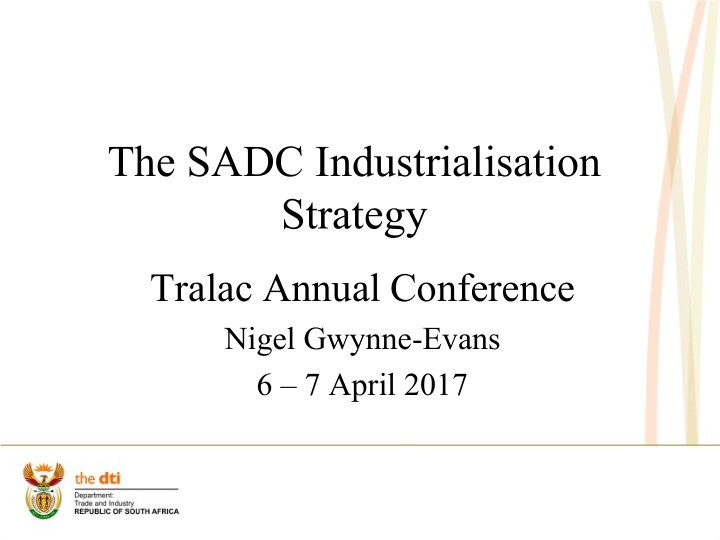



The SADC Industrialisation Strategy Tralac Annual Conference Nigel Gwynne-Evans 6 – 7 April 2017
Background • Takes its cue from AU’s agenda 2063 and the Regional Indicative Strategic Development Plan (RISDP) • Industrialisation Strategy and Roadmap – early 2014 – Adopted April 2015 • Summit tasked the secretariat to develop a Costed Action Plan • Finally adopted March 2017
SADC Industrial strategy: Core tenets • Seeks to engender major economic and technological transformation • The Strategy is anchored on three pillars, Industrialization as champion of economic and technological transformation, Competitiveness , and Regional Integration . • Identifies infrastructure, finance and skills development as key binding constraints to industrialization. • It identifies agro-processing, mineral beneficiation and pharmaceuticals as priority growth paths.
Key interventions up to 2020/ $60m indicative cost:22 Projects • Value-chain strategies and implementation • Initiation of the IUMP – upgrading programme • Cluster development programme • Strengthening regional private sector structures • Strengthening and prioritising industry skills programmes • ID and facilitate critical regional centres of excellence • Prioritisation & sequencing of critical trade facilitation measures along priority corridors
Main questions in developing the Action Plan • Challenge of working with a diverse gaggle of consultants • The need to move up and diversify into new VC’s rather than just increased participation in GVC’s • Importance of focusing on and building regional VC’s • Insufficient focus on industrial policy tools – introduction of an IP “toolbox” • Questions of member state vs role of the secretariat • Roles and responsibilities of member states vs the secretariat in the implementation • No reference to the 4 th Industrial Revolution • High number of projects & programmes (50)
Key operational challenges • Political will and buy-in by member-states • Capacity to implement by both the member states and with the secretariat. • Ability of member states to influence other key departments in the interest of IP progress • Limitations of donor funding • Lack of a coherent and engaged private sector • Timing – and ability to achieve quick wins • Member state self-interest & tension between trade liberalisation and defence of national positions • Not getting stuck in research
Key Success Factors • Political will to put industrialisation as the highest priority amongst member states • Ability to build capacity within member states & the new SADC industrial directorate • Regional integration – will it provide the impulse to create the economies of scale required (SA’s hegemony?) • Ability to influence key enabling factors: Infra-structure; skills; critical institutions etc. • Openness to engaging with and responding to the needs of the private sector (concept of “active IP” and “ embeddedness ”) • Ability to focus on quick-wins – but long term vision
2017 SADC Summit - SA “ Strengthening capacity to partner with the private sector in developing industry and regional value- chains”
Thank you. Ngwynne-evans@thedti.gov.za
Recommend
More recommend